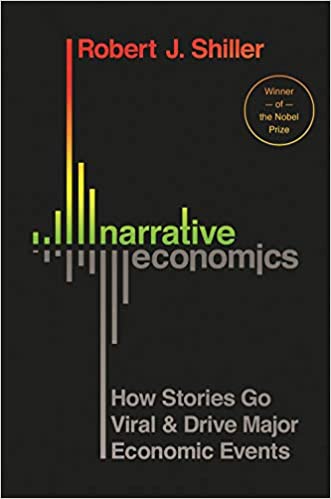
Robert Shiller starts one of his lectures writing “RITUPARNA” on the board, asking the students who it was. Nobody knew. In Mahabharata, King Rituparna gave Nala, disguised as Bahuka, his charioteer, an estimate of the leaves and fruits on the branches of the Vibhitaka tree, and those on the ground. Nala counted and confirmed the estimate. Rituparna would teach Nala the art of gambling in exchange for the skills of a charioteer.
Simple stories propagate complex ideas faster in popular narratives. The role such narratives play in shaping economic ideas and policies is the subject of Shiller’s new book, “Narrative Economics: How Stories Go Viral and Drive Major Economic Events.” It draws parallels between narrative epidemics and medical epidemics to show that incorporating narrative economics is the best way for economists to advance their science.
The book takes forward the discussion started in Shiller’s “Irrational Exuberance,” and continued with “Animal Spirits,” and “Phishing for Phools,” both co-authored with George Akerlof. Shiller synthesises the ideas in these books, and “Identity Economics” by Akerlof and Kranton, links them to epidemiology, and proposes that thought viruses lead to many important economic events.
“Narrative economics” focuses on two things: one, the contagion of ideas in the form of stories, and two, generating new contagious stories or making stories more contagious. The dominant “stories” keep changing, altering economic behaviour. Studying the viral spread of such narratives can improve our ability to anticipate and prepare for economic events. It also helps structure economic institutions and policy.
An economic narrative is a contagious story, which is oversimplified and easily transmitted, and has the potential to colour and direct people’s loose thinking and how they take economic decisions. But, as in an epidemic, not everyone becomes infected. Many of those infected might recover faster than others.
The infection peaks and tapers off over time, in hump-shaped patterns. Shiller cites four such theories in economics, the IS-LM model (Hicks, 1937), the multiplier-accelerator model (Samuelson, 1939), the overlapping generations model (Samuelson, 1958), and the real business cycle model (Kydland and Prescott, 1982).
The Laffer curve went viral in popular imagination in the 1980s because of the simple relation it suggested of higher taxation reducing national income. The idea got a push with Ronald Reagan’s famous quip: “Government’s view of the economy could be summed up in a few short phrases: If it moves, tax it. If it keeps moving, regulate it. And if it stops moving, subsidize it.” Such simple and easily transmittable ideas can go viral. The quote and the narrative contributed to tax reductions in the US and in UK under Thatcher.
This influence of popular narratives on economic decisions and policy is one reason why we have self-fulfilling prophecies. Flashbulb memory of short narratives in the form of anecdotes, or even a smaller part of it, could spur economic decisions suggested by them. But, creating a narrative contagion is not always easy. For instance, hardly anyone travels today without a piece of luggage with wheels. But for almost a century those who suggested the idea were laughed at.
The meaning of a narrative could also change over time. For instance, “American Dream” stood for a frugality narrative during the Great Depression, but today justifies conspicuous consumption, advertising one’s accomplishments with moral rectitude.
Each narrative coins new terms and pet phrases, such as gold standard, bitcoins, and technocracy, which become self-propagating in popular imagination. While it is difficult to predict the actual effect of artificial intelligence and machine learning on future employment and production patterns, the narratives around them could amplify economic cycles and influence policy. Such economic narratives are particularly influential in speculative markets, such as real estate and stock markets, and bring on an economic crisis. The old Bank of Bombay went into liquidation in 1867 due to financing a share mania around reclamation projects. Bank managers, shareholder directors, government directors, and a gullible public were complicit. It found resonance a century and a quarter later in the Harshad Mehta scam of 1992.
As no one index can capture the entirety of what it seeks to measure or represent, narratives have a role to play. But, the underlying narratives that could help in understanding economic developments might be lost in a mass of data, not collected or presented with a view to discovering such narratives. But, older hard data might not be useful where new technology could worsen contagion rates and speed of recovery.
Future research needs to provide better links between mathematical economics and humanities and how narratives can be factored in forecasting. Such research needs to be a part of mainstream economics. For this, collecting better information about changing narratives should start now. This could be through content analysis, focused interviews that would generate stories on economic decisions, regular focus groups to elicit conversations about economic narratives, and building digital and searchable databases of personal letters and diaries. Research also needs to hold hands with psychology, neuroscience, and artificial intelligence to improve sense of structure in narrative economics.
Shiller uses seven propositions to build a framework to study past economic narratives. These are as follows:
- 1. Epidemics can be fast or slow, big or small
- 2. Important economic narratives may comprise a very small percentage of popular talk
- 3. Narrative constellations have more impact than any one narrative
- 4. The economic impact of narratives may change through time
- 5. Truth is not enough to stop false narratives
- 6. Contagion of economic narratives builds on opportunities for repetition
- 7. Narratives thrive on attachment: human interest, identity, and patriotism

Shiller concludes that without incorporating contagion of narratives into economic theory and forecasting, “we remain blind to a very real, very palpable, very important mechanism for economic change.” Reading how epidemics of popular narratives influence economic behaviour is ideal for pandemic times.
Robert Shiller is a Nobel Laureate in Economics in 2013, with Eugene Fama, and Lars Peter Hansen, “for their empirical analysis of asset prices”.
© G Sreekumar 2021
For periodical updates on all my blog posts, subscribe for free at the link below:
https://gsreekumar.substack.com/
![]()